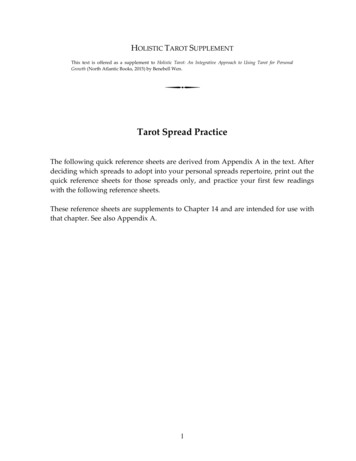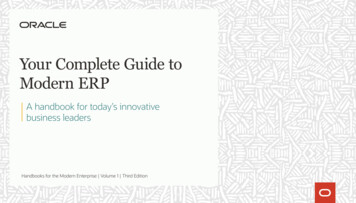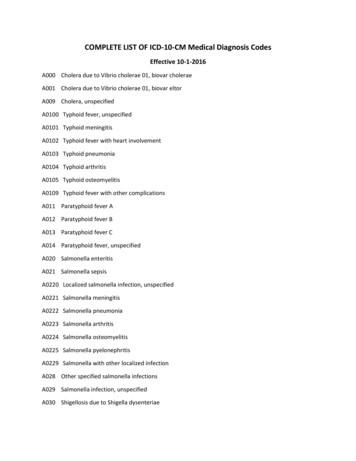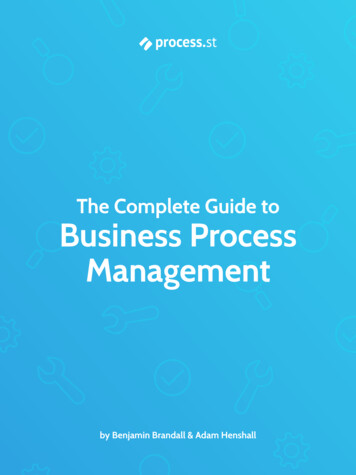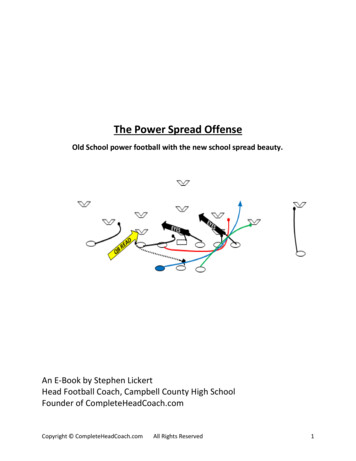
Transcription
The Power Spread OffenseOld School power football with the new school spread beauty.An E-Book by Stephen LickertHead Football Coach, Campbell County High SchoolFounder of CompleteHeadCoach.comCopyright CompleteHeadCoach.comAll Rights Reserved1
Table Of ContentsBackground of the SystemPage 4The Why’s and What’s of the systemThe PositionsThe Formation SystemPlayer AlignmentThe Run Game The Blocking System and Acronymso The Power Playo The Slam Playo The Counter Playo The Dive Playo The Trap Playo The Iso Playo The Sweep/Toss PlayPage 5Page 8Page 9Page 12Page 14Page 15Page 20Page 21Page 22Page 23Page 24Page 25Page 26The Passing Game Protection Schemeso The Hot Passeso The Quick Passeso The Play Action Passeso The Sprint Out Passeso The Drop Back Passeso The Screen PassesPlay Calling The No Huddle Wristband SystemPage 27Page 27Page 29Page 31Page 34Page 36Page 38Page 43Page 44Copyright CompleteHeadCoach.comAll Rights Reserved2
The Power Spread OffenseOld School power football with the new school spread beauty.A system designed to spread the field and Run or Pass based upon your personnel.The origins of this offense come from the split back misdirection offense that weran while I was a player under coaching great, Dale Mueller at Highlands HighSchool. When I was hired at Dayton High School in 2004, I tried to install the systemand found that the rules and blocking schemes were very difficult for my kids tolearn and began studying the wing-t and double wing blocking schemes. Afterspending numerous hours studying and trial and error, I turned our blockingsystem into an acronym based system and this simplified our rules greatly.After year one at Dayton, I was also looking for an edge to give our guys the bestchance to be successful. We had a returning QB that was a great runner. This wasduring the beginning of the shotgun boom and we installed the shotgun in orderto give our team an opportunity to outnumber teams at the point of attack. It wasduring this time, that I was also developing our passing game and fell in love withthe ease and progression reading system of the Air Raid offense. I did not feel wecould run the Air Raid offense exclusively, but we adopted many of the conceptsto create a comprehensive menu of offense that we could run and adapt each year,based upon the talents of our players. This was the beginning of the offense thatwe continue to run today with good success. The offense can be run from undercenter and I recommend doing it from under center in the youth leagues.Finally, it would be a total fail to not mention the impact the Georgetown Collegecoaching staff have had on my coaching style and way of doing things. Bill Croninand Dave Campbell, as well as the rest of the staff have been instrumental in mydevelopment as a coach and the processes behind why we do the things we do!Acronyms to know while readingLOS Line of ScrimmageEMLOS End Man On Line Of ScrimmageLM LinemanMDM Most Dangerous ManCopyright CompleteHeadCoach.comAll Rights Reserved3
Why the power spread read?The power read was developed during the boom of the zone read offenses. Aftertrying to implement zone principals and studying the zone running attack, I noticedthat most zone teams were running mostly zone exclusively. The zone is anexpensive football play. What I mean by that is it takes a ton of repetitions toperfect and therefore it cost a lot of practice time to perfect. We also have issueswith our lineman being foggy on who to block. We found that our kids were muchbetter with a gap and man blocking scheme. The beauty of it is we still get the“read” part of the “read” zone, without running the zone. We have truly found thispower read scheme to be a game changer for us, especially on plays when we pulla guard such as power, counter, trap, etc.Things to Think About While ReadingThis book is a basic introduction to the Power Spread Offensive system and focusesmainly on two backs. The system is designed to be run using your best personnel.If you have a bunch of good receivers, you can go 4 wide receivers and 1 back. Weutilize the single back run game almost exclusively and have run the QB some yearsand other years not as much. The reason the book focuses on two backs is becausethat is probably the best way to teach the system in the first year and then addreceivers once the system is mastered.This is the base, but not the whole system. Many of the single back run game playsand diagrams are excluded as well as some other passes that we run. This was doneby design as to not give too much offense. In my opinion, you should almost beable to practice your whole offense in one day. The focus on the book was to givethe basics, which on its own is plenty of offense.Keeping It SimpleThe power spread offense is designed to be very simple to run and install. Thewhole system can be installed within 3 – 5 days and then you get reps, reps, reps.Keeping the rules simple for players allows them to play fast because they knowthe rules and just need to apply them.Copyright CompleteHeadCoach.comAll Rights Reserved4
This is an offensive line centered attack. This means we looked at the offensiveline and developed the power read so they don’t have to know a lot of differentschemes. The rules also serve as a confidence booster for the kids, because theyknow they can block any front they may see. All in all, our line needs to know fiveschemes:Gap Schemes1. Power/Counter – These are almost identical blocking schemes. The onlydifference is who kicks out and who leads through.2. Trap and Iso– These are a gap scheme with the same blocking rule systemas power/counter.Man Schemes3. Slam/Dive/Belly – These are all man blocking schemes. Guys go get therenumber.Reach Schemes4. Toss/Sweep/Jet/Hot passes same reach or pin and pull blocking scheme.5. Sprint Out PassMixture of Gap and Reach6. Slam Pass/Boot Pass/Waggle PassBOB Slide Protection Scheme7. Quick Pass same blocking scheme8. Drop back passScreen Scheme9. Slip and WR screen same blocking schemeAs coaches, the days of teaching the kids how to block this front or that front on aweekly basis are gone. This is good because you can focus on what you do andthe fundamentals, rather than worrying about what the defense is doing.Copyright CompleteHeadCoach.comAll Rights Reserved5
Quick and Easy InstallationThe installation of this system is very quick and easy. We have all been to the firstday of practice when kids don’t know there rules or blocking assignments sotrying to run plays can look like a cluster. With the power read, we utilize awristband system, but not just any wristband system. Our wrist card not only tellsthe kids the play, but also it tells them their rule or assignment.Here is an example of what a Left Tackle card could look like:0 trp- SFTCF1 trp- FBI2 Belly- SFTCF3 Belly- on out bkr4 ctr- pull lead5 ctr- GDB6 slam- SFTCF7 slam- GOBkrWith utilizing our wristband system, we spend ALL ofindividual time teaching individual techniques andfundamentals like how to gap block how to reach block,how to pull, etc. Once they know these fundamentals, wecan run any play on our wristband on day one. We do notdo that, but we could if we wanted to do so. In my opinion,the utilization of our wristband system is easily the bestway and most effective way to install an offense.8 Jet- rch z one R - bkr9 Jet- rch z one L - bkrBalance within the systemThe definition of balance within the Power Read is to utilize all eligible skillplayers. We want the defense to have to defend the whole field. In many years,we have had 8 – 10 guys score touchdowns, catch balls and carry the football.When defenses cannot key on one player, they have a tough time getting stopsand they cannot gamble as much. Your opponent must be sound on defense orwill get burned by the guy they do not respect. We have had some years wherewe struggled to get people to respect some of our players and the defenseloaded the box. As a play caller, you need to have devised a plan to get differentpositions the football so they have to respect that position and it keeps thedefense honest. This distribution can be done multiple ways and very efficiently.We like to consider out hot pass and quick pass game to be extensions of ourrunning game.Copyright CompleteHeadCoach.comAll Rights Reserved6
The PositionsSkill PositionsY Tight End. Our Y needs to be a tough physical kid who blocks well, but can alsocatch the football.H Slot Receiver/ 2nd Running back. This is the smaller, scat back, Wes Welker typeof guy. Ideally, this player can also play running back so you can move into a 2 backset without a personnel change.X Best Receiver. Weak side receiver. Go to guy. Guy you want to isolate in tripsformations.Z Possession Receiver. Strong side receiver in base formations.F Best Running Back. This player needs to be willing to lead block and pass block.Q Quarterback.Offensive LineTackles – Our Tackles stay Right or Left. They do not switch sides. These are biggerguys that need to be able to run so they can pull on certain plays, but can be lessathletic than the Guards.Guards – Our guards stay Right or Left. They do not switch sides. These can besmaller guys, but need to be able to run because they will be pulling on a lot ofplays.Center – Needs to be able to shotgun snap and block back. Also needs to be smartand able to communicate.COACHES NOTE - We use pre-practice each day and EVERY lineman works onshotgun snapping. We will never be in a situation where we cannot get the snapbecause all of our linemen work on snapping the football daily.Copyright CompleteHeadCoach.comAll Rights Reserved7
The Formation SystemThe formation is a system of tags off of our base formations that are simply namedLeft and Right. This system is designed to use as few words as possible.Y – To the call. Inside Receiver. ON the LOSZ – To the call. Outside Receiver. OFF the LOSH – Away from the call. Inside Receiver. OFF the LOS.X – Away from the call. Outside Receiver. ON the LOSF – Lines up according to the play unless tagged to be in a specific spot. (This is rare)The formation system is arranged around where our Y (Tight End) and our X (BestReceiver) line up. The Y is always TO the direction call and the X is always AWAYfrom the direction call. The H (Slot) and the Z (Possession Receiver) are floaterswhen tagged, but the base rule is Z goes strong with the Y and H goes weak withthe X.From the base Left and Right formations are a number of Tags that tell differentpeople where to line up. Our receivers do line up on both sides due to the passinggame that we run and the QB’s progression reads.Copyright CompleteHeadCoach.comAll Rights Reserved8
Base Formation Tags for the HMAX – This tells the H to line up in the backfield. If your H is a true receiver type ofkid, you can insert a 2nd back when using a MAX set. **THIS IS CONSIDERED THEBASE FORMATION OF THE OFFENSE**HOP – The H will line up OPPOSITE his base rule.As you can see, everyone else lines up with normal base rules and only the Hmoves.Base Formation Tags for the ZFLIP – This tells the Z to line up OPPOSITE his base rule and INSIDE the X.Combination of TagsFlip Moves the Z opposite and inside the X. Max moves the H into the backfieldfor a 2 back set.Copyright CompleteHeadCoach.comAll Rights Reserved9
The Running GameThe Base run game consists of 7 running plays in order to create comprehensiveattack and forces the defense to defend every hole on the field. These plays aredesigned to look like each other in order to create deception and conflict in thedefense.The Base plays consist of: Dive Trap Belly Counter Power Slam Sweep/TossRun Blocking Rules and AcronymsOur blocking rules are a progression, acronym based system. This means that theplayer applies the rule in order and when a defender is lined up in the techniquecovered by the rule, the lineman stops and blocks that person.For example, the main rules of the gap scheme system is listed below:Gap Inside Gap – Defender is in the gap between you and your inside lineman.On Man on – Defender is “on” the LOS and his helmet is between the shoulderpads of the blocker. You will be the post man on the double team. Keep eyes insideand get hips tight to down blocker.Outside Outside gap – Defender is lined up between you and the lineman to youroutside.Down Defender is “On” the first man to your inside and no further. Drive blockhard to the inside. If defender slants away, DO NOT CHASE! Continue on track tothe next level.Copyright CompleteHeadCoach.comAll Rights Reserved10
AcronymsG.O.D. Gap – On – DownG inside gap / Back Side GapO man on / CoveredD Down blockG.D.B Gap – Down – BackerG inside gap/ Back Side GapD down blockB BackerThe Power PlayThe power play is very similar to counter except the lead back kicks out and theguard leads onto the backer. The power is a very good change up from counterwhen having trouble with being chased down from the back side and also withattacking blitz heavy teams.Keys to the play: Gap blocking scheme that is great against all fronts.Flexible on whom to block, whom to kick and whom to lead onto.Gives ability to outnumber the defense at the point of attack.Copyright CompleteHeadCoach.comAll Rights Reserved11
The Passing GameThe passing game in the power spread consists of hot passes, Quick passes, sprintout pass, play action passes, screens and some drop back pass plays. From thestandpoint of timing and ease, the drop pattern of the QB is different on eachconcept. Hot Pass catch and throw. Treat the ball as if it is a “hot potato”. We tellthe QB not even to find the laces. Just catch and throw to the calledreceiver. Quick pass 0 to 1 step drop from the gun. Catch the ball, change your feetand find the laces while reading the key defender and throw the ballopposite the key defender drop. Drop Back passes 3 step drop from the gun. Catch the ball. Drop and findlaces with eyes on progression read. Sprint out pass drop step banana roll out to call side. Full sprint with eyeson progression. Get shoulders square to the throw. Play Action Pass sell fake to back. Same as sprint out from there. Takeyour time on fake. Screen Sell 3 step drop pass with eyes down field. Throw to calledreceiver while fading away from contact. If he is not open, throw at feet.Do not over throw unless thrown out of bounds.Copyright CompleteHeadCoach.comAll Rights Reserved12
The Hot PassHot passes are a system of bubble screens, juke screens and swing screens thatare quick hitting and designed to get 5 yards. The QB need to catch and throwimmediately to the called receiver. These are very effective ways to get the ballfast to your play making receivers in space. The blocking rules are very simple.With the new trend in RPO’s the hot pass series is a great way to introduce them.The Juke RouteThe Juke Route goes to the most outside receiver on the called side. The WRsimply takes one step and pops back behind the LOS.Copyright CompleteHeadCoach.comAll Rights Reserved13
The Quick PassThe Quick passing game is a very valuable, easy to use system that is predicatedupon finding the flat defender in the defense and reading him. This is a timingbased system in which the QB will catch, read and throw. The base quick passsystem is hitch and seam, fade with out, and slant with arrow. These threeconcepts give you an attack that can be utilized to defeat what the defense isdoing and give you an opportunity to attack different parts of the field. The quickpass system is also a mirrored system, which means the front side and back siderun the same route combinations.The name of the play tells the Outside #1 receiver what to do. IE. Hitch #1receiver running hitch, Slant #1 receiver running Slant, etc.Quick Pass HitchThe hitch is designed to be an easy throw and catch. It is best used against loosecoverage by a corner. WR needs to sell deep and then break of route and gethead around.Copyright CompleteHeadCoach.comAll Rights Reserved14
The Play Action PassSlam pass is a great play in the power spread. It is an awesome compliment to thepower run game and an easy throw and catch for the QB. The QB read is Deep toMiddle to Short. A lot of the time, the QB does not have this much time and bydefault, we tell him we want the 5 out. This play is best run to the TE or 2 receiverside to get the true flood route, but is also good weak.Sprint Out PassComebackThe comeback is a go to 3rd down type of play it is designed to get the first down,but all Rodeo/Lasso gives the QB a run/Pass option so you can take what thedefense s giving you. We will run this play on any down and it is one of the bestplays in our system.Copyright CompleteHeadCoach.comAll Rights Reserved15
The Drop Back PassThe drop back pass series uses mostly Air Raid Concepts and are progressionreads. This basically makes the drop back game back yard football. The QB looksat his 1st read and if he’s open, he throws it. If he’s not open, he moves his eyes tohis 2nd read. If he is not open, he moves to his 3rd read. Very rarely, if ever will theQB get to his 4th and 5th read.We do utilize multiple run and shoot concepts as well as 4 verticals, but for thepurpose of the 2 back game. These are the plays we focus on.Although the passing scheme is a progression read, it is still important the QBunderstands coverages. I have created a PowerPoint that explains the process weuse and it is available under free playbooks and is named Coverage PowerPoint.The plays in the drop back game are: MeshY-Cross- Weak side floodY-Sail – Strong side floodCurlShallowMeshThe mesh is a great play! It is excellent on the goal line when teams like to manup. It is difficult for LB’s to cover. Mesh is a good play any place on the field.Copyright CompleteHeadCoach.comAll Rights Reserved16
Hello Coach,Thank you for your subscription to my blog. If you enjoyed the sample and areinterested in getting more with complete detailed information of the basesystem, you can purchase the whole E-Book for the low price of 7.95 on myproducts page.The whole book includes the following: 45 pages of detailed information about the system. All base formations including no TE Sets. Complete explanation of the blocking rules system, acronyms, numberingand numbering system with diagrams and scenarios. Complete explanation of the QB read and rules with diagrams. All of the base run game with diagrams. All of the base passing game including 4 Hots, 3 Quicks, 2 Screens, 2 PlayActions and 5 drop back passes. The pass protection schemes with diagrams. Detailed explanation of the play calling system utilizing wristbands. And much more inside information about the system.Copyright CompleteHeadCoach.comAll Rights Reserved17
“read” part of the “read” zone, without running the zone. We have truly found this power read scheme to be a game changer for us, especially on plays when we pull a guard such as power, counter, trap, etc. Things to Think About While Reading This book is a basic intr
